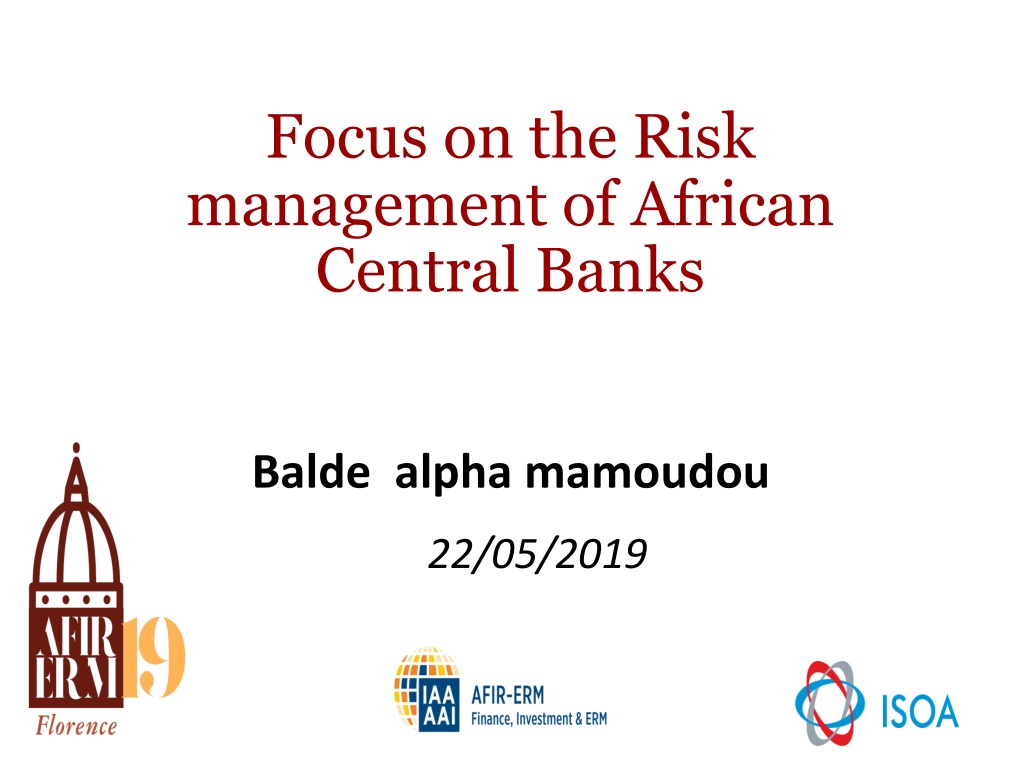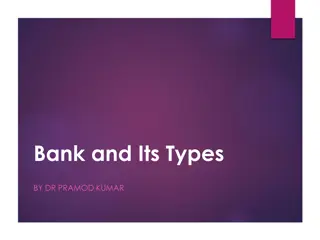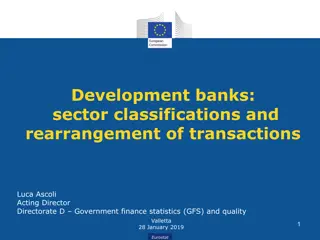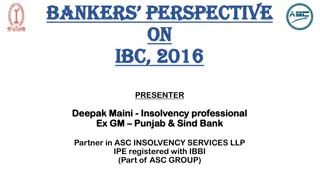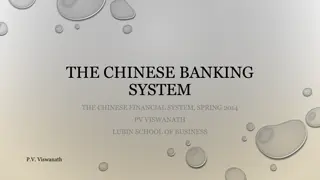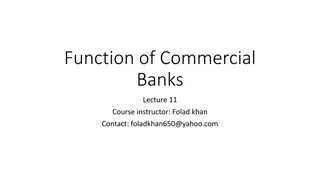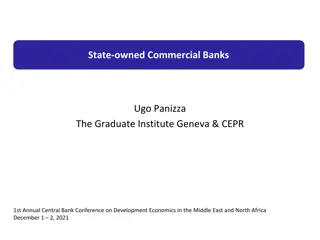Risk Management Challenges in African Central Banks
African central banks face challenges in risk management, particularly in trade banks default payments, credit risks, and handling electronic money. The banking sector in Africa shows weaknesses in lending to small and medium enterprises and lacks a strong capital market infrastructure, impacting the financial sector's growth. Despite experiencing growth, African financial markets still struggle with limited banking penetration rates and access.
Download Presentation

Please find below an Image/Link to download the presentation.
The content on the website is provided AS IS for your information and personal use only. It may not be sold, licensed, or shared on other websites without obtaining consent from the author. Download presentation by click this link. If you encounter any issues during the download, it is possible that the publisher has removed the file from their server.
E N D
Presentation Transcript
Focus on the Risk management of African Central Banks Balde alpha mamoudou 22/05/2019
Agenda Degree of maturity of African financial markets Focus on the Risk management of Trade banks default payments risk credit challenges of central banks Central banks and risk management framework-focus on the monetary policy Central banks Risk management of electronic money and Mobile banking Promoting actuarial function in risk management staff and use of Big data conclusion
VIEWS ON AFRICAN Banking SYSTEM In the majority of African countries except south africa, the financial sector is essentially the banking sector; in developed countries, it also includes the equity and corporate bond market, the insurance market, the mutual funds ; escaping the contagion of the US high-risk lending crisis 2018 also highlighted weaknesses in the African financial sector and its weak integration into the global financial system; Banks in Africa also tend to be extremely liquid; they benefit from an abundance of deposits, generally put in reserve or invested in instruments (often governmental) of the money market in the short term. It would seem, therefore, that African bankers have little incentive to develop loans to SMEs; it is difficult to develop a strong capital market infrastructure on the basis of such a weak banking sector; The majority of banks tend to lend to governments through, among other things, buying treasury bills. The amounts of government bonds and loans granted to public enterprises are, by the way, much higher than in any other region; Recent work shows the close correlation between the size and efficiency of the financial and banking markets. A well-developed banking sector therefore appears to be a precondition for the emergence and expansion of a financial markets-and stocks markets,
Banking and stocks markets in africa African financial markets have experienced spectacular growth since the early 1990 FROM a dozen, they are now 23 and cover the entire continent. Market capitalization has increased nine fold, and more than 2000 companies are now listed. However; there are no products that are still derived like CDs or CDo * Thanks to privatization programs, hundreds of thousands of Africans have become shareholders of the big companies in their countries. Popular shareholding and capital participation of employees; Two indicators are used to measure the structure of a financial system. The first, called "activity- structure", measures the importance of stock exchanges versus banks in a country's financial system. The second, called "restriction", measures the regulatory restrictions imposed on banking activities. To examine the impact of the level of development of finance, a global indicator - called "activity-finance" - takes into account both the development of banks and stock exchanges. the banking sectors in this zone are generally small - a small number of establishments - and their penetration rates in the economy and in the population remain limited. Business access to banking is difficult, and less than 20% of individuals have a bank account.
Banking and stocks markets in africa -few statistics
Banking and stocks markets in africa -few statistics
Banking and stocks markets in africa Maturity of banks Public savings - Employees shareholding Capital markets development economic Support of FUNDS SFI/WB Growth yield curve Cotation enterprise's Financial transparency standards IFRS
FRAMEWORK ON WAMU ZONE MACROPRUDENTIAL BANKING REGULATION Three main standards are used to assess the solvency of the banks of WAMU (WESTERN AFRICAN MONETARY UNION) in phase with Basel Guidelines: The representation of the minimum capital, the rules of coverage of risks and those relating to the limitation of fixed assets and participations, in liaison with the level of regulatory capital of each bank. The representation of the minimum capital requires UEMOA credit institutions to hold at any time basic capital at least equal to the legal minimum capital or fixed in the approval decision (1 MFF CFA). As at December 31, 2010, 76% of banks meet this requirement. The capital and dividend limitation ratio aims to ensure that banks finance their fixed assets with own resources. For this purpose, the total amount of fixed assets and investments may not exceed 100% of banks' actual capital. From 2001 to 2009, this ratio decreased to 82% in 2010. One of the prudential ratios that is more specifically related to good governance is that of the indebtedness of staff and directors (agents and directors) on own funds that must not exceed 20% (it is specific to Central Africa). and West). The granting of internal loans must comply with the principles ensuring the safety and soundness of the bank. Intended to prevent liquidity risks in the very short term of the banking system, the liquidity ratio requires banks sufficient funds or jobs whose residual duration does not exceed three months to cover, at least 75% , their liabilities of the same maturity. On average, 63% of banks comply with this standard in WAEMU over the period 2000-2010. The central bank focuses on the risk management of credit risks; liquidity and systemic Risk,
FRAMEWORK ON WAMU ZONE MACROPRUDENTIAL BANKING REGULATION The portfolio structure ratio is based on the system of classification agreements of the central bank, the ultimate goal being to encourage banks to hold healthy assets that can be used to support refinancing of the central bank and put in place a qualitative monitoring tool for their loan portfolio. It is defined as a ratio between the outstanding loans benefiting from the classification agreements issued by the issuing institution to the reporting bank and the total gross credits of the institution concerned. Thus, credit institutions are required to comply with the rule setting a minimum ratio of 60% between healthy loans outstanding with central bank classification agreements and the total volume of their portfolio. At the end of December 2010, no bank respects this ratio, two less than in 2009. Thus, even though WAEMU banks are generally making efforts, compliance with prudential rules is still weak and certain standards are not in line with international provisions, particularly on risk concentration (IMF, 2012, p.14). AND ANYWHERE An approach to capital regulation, based on the theory of incentives, is developed by Besanko and Kanatas (1996). The latter reason in an imperfect information environment. If a bank makes a forced recapitalization to meet the imposed requirements, the price of its shares will fall (Barth et al., 2004, Kopecky and VanHoose, 2012). This decrease comes from the reduction in the effort made by the former shareholders (insiders) in the financing of risky loan investments. The risk management culture of African banks is weak - no incentive in the PORTFOLIO risk mangers- ALM actuaries- or financial engineers- etc.
Focus on the Risk management banks default payments Risk credit challenges of central banks Many countries are thinking of more innovative solutions to support economic growth in coaching this risk of bank defaults. There is a classic formula for categorizing bank claims according to their degree of risk: sound debts (probability of total recovery close to 1) and outstanding debts. Accounts receivable also consist of pre-doubtful accounts (the payment did not occur 90 days after the end); (The payment did not occur 180 days after the end) and the debts were compromised (the payment did not occur 380 days after the due date).
Focus on the Risk management banks default payments challenges of central banks The Risk and litigation departments of the banks often have a lot of work on the board to clean up bank defaults. The automatic triggering of legal proceedings becomes inappropriate especially in developing countries due to the complexity of the large files and the number of litigation clients; and the loss value of assets during the long Time of legal procedures. Bank management is aware of this reality and must in favour negotiated solutions because putting a credit in litigation often means that it has not been well launched at underwriting or has not been well followed following its implementation rules ; This also reflects the inability of both parties, the bank and the customer to find a solution able to preserve their relationships. Banks must seek to negotiate to cover the maximum through reprofiling formulas; Rescheduling; Lower rates; Postponement of maturities or partial abandonment of the claim accompanied by a "return to better client" clause.
Challenges default payments of Moroccan banks the Bank al Maghrib has set up a large mediation center and also strengthen its capacities through quantitative credit rating and minimising the volum of defaults payments and clients behaviour, The bank al maghrib has outsourced it central of risk to a the Extern operator called experia in order to share database of clients banks credits and to bring more information to credit decision makers;
Challenges default payments of Moroccan banks Central banks in Africa must push banks out of the traditional pattern to which they are accustomed by encouraging negotiated and practical solutions such as : 1-The dation in payment It is a formula increasingly used by Moroccan banks. It is simply the partial or total repayment of a credit by the transfer to the bank of a property; Usually a building. It is legitimate to ask what the banks will do with all these land reserves. Precisely, the central bank must control the size of these assets in the "Fair value" balance sheets at the limit of a portion of the shareholders' equity. 2- Sale with repurchase Same also sale with faculty of redemption; It is very little known in Africa even in the banking sector. It is a formula by which the buyer binds himself after the perfect sale, to return the thing to the seller against reimbursement of the price. The seller must exercise its faculty of redemption within the period agreed with the buyer which must not exceed three (3 years. Its implementation requires a fairly complex legal and financial set-up and advantageous tax provisions in the Regulator's finance laws. 3- the clause to return to Best fortune It allows the bank that gives up its claim in whole or in part; To require a full or partial reimbursement of the client's benefit if the situation improves in the future.
Central banks focus on the monetary policy-Head Lines Several reforms are also underway with a view to improving the regulatory framework of the financial system in the Union WAMU. These notably include projects focusing on: the adoption of macro-prudential supervision indicators for the banking and financial sector; the identification of banking institutions with systemic importance, consolidated monitoring of banking groups and supplementary supervision of financial groups; Managing credit Risk and liquidity of banks to enhance the Price stability of WAMU; he level and structure of an economy's debt, especially if denominated in foreign currency, can hinder the central bank's ability to pursue its monetary objectives; A depreciation of local currencies may also lead to vulnerabilities in areas where foreign currency assets or earnings are insufficient to offset foreign currency liabilities, which may be a problem for some CENTRAL banks in Africa (the banking sectors of The Gambia and Rwanda, for example, had net open positions in slightly negative currencies in 2017).
Central banks focus on the monetary policy Public debt risk management At a time when protectionism is increasing and interest rates are rising elsewhere in the world, there is an urgent need to ensure that the debt of African countries, which is already rising, does not hinder efficiency. their monetary policy. Given the integration of African economies into global value chains, protectionism would likely result in lower export earnings and increased demand for external financing; rules preventing direct central bank financing by central banks, inflation targeting under monetary policy, and operational independence could help to maintain the effectiveness of monetary policy; CENTRAL BANKS IN AFRICA CAN NOT ACT DIRECTLY ON PUBLIC DEBT BUT CAN COMMUNICATE AND ADVISE PUBLIC ENTERPRISES on the impact of the accumulation of debt on monetary policy; In addition, the National Bank of Rwanda participates in joint committees with the State Treasury and the Debt Management Office to refine the government's macroeconomic policies and forecasts. In Botswana, the central bank advises state-owned companies that are looking to increase their debt.
Central banks Risk management of electronic money and Mobile banking The world is going digitaly; electronic and mobile banking is not an option of african central banks ands a new framework of assessment risks management; Whole African informal sector needs more solutions Fintech for more financial inclusion; Electronic payment media are likely to figure importantly in the development of electronic commerce, and retail electronic banking services and products, including electronic money, could provide significant new opportunities for banks. Electronic banking may allow banks to expand their markets for traditional deposit-taking and credit extension activities, and to offer new products and services or strengthen their competitive position in offering existing payment services. In addition, electronic banking could reduce operating costs for banks.
Examples of possible risks electronic banking and electronic money the Basle Committee since 1998 recognizes that along with the benefits but electronic banking and electronic money activities carry risks for banking organizations, and these risks must be balanced against the benefits. The matrix below provides examples of possible risks banks may face in engaging in electronic banking and electronic money activities, and notes possible measures banks may use to manage such risks. The list is representative rather than exhaustive.
Examples of possible risks electronic banking and electronic money
Examples of possible risks electronic banking and electronic money
Promoting actuarial function in risk management staff and use of Big data Actuaries have the tools and skills in the bnaking Risk management staff (exchange risks- credit risk valuation-VAR- Montecarlo-stress Tests) , A strong Framework of Risk management should value this function ; The World is going digital and what means is opportunities of electronic/Internet Banking, so Datascientist and big data engeeners should help central Banks to detect Frauds in financial transanctions ( Neural networks-SVM) and help banks to analyse clients credits Profils*
